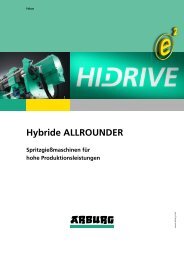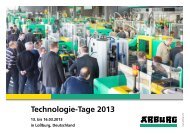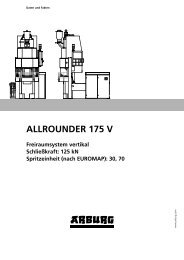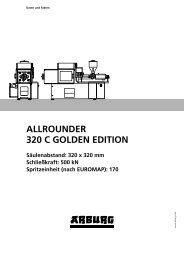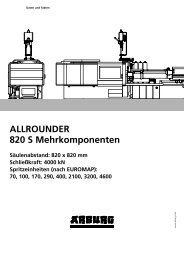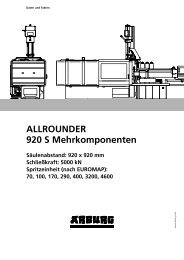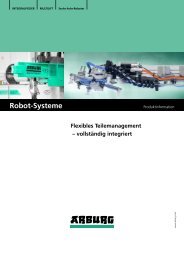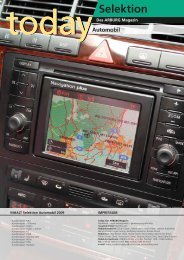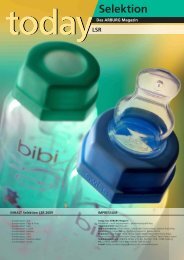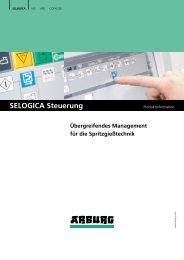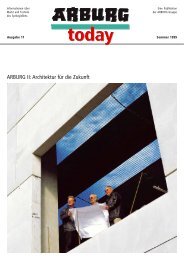GB - Arburg
GB - Arburg
GB - Arburg
Create successful ePaper yourself
Turn your PDF publications into a flip-book with our unique Google optimized e-Paper software.
The ARBURG magazine Issue 33 Autumn 2006
CONTENTS<br />
4<br />
7<br />
8<br />
9<br />
10<br />
11<br />
12<br />
14<br />
15<br />
16<br />
18<br />
19<br />
MASTHEAD<br />
Fakuma<br />
Double success<br />
Fakuma<br />
World premieres at the Fakuma<br />
GOLDEN EDITION<br />
Unbeatable offer<br />
Customer report<br />
Balda AG: big in international business<br />
Family Day<br />
Family party at Lossburg<br />
Partner Day<br />
Together into the future<br />
Project<br />
FELSCH Spritzguß GmbH: a major challenge<br />
Subsidiary<br />
Impressive new building<br />
Tips & tricks<br />
Total access<br />
Customer report<br />
FRANK plastic AG: one for all<br />
History<br />
Milestones<br />
Tech talk<br />
Drying assures quality<br />
today, the ARBURG magazine, issue 33, Autumn 2006<br />
Reproduction – even in part – only by express permission<br />
Responsible: Dr. Christoph Schumacher<br />
Editorial advisory board: Juliane Hehl, Martin Hoyer, Herbert Kraibühler,<br />
Bernd Schmid, Jürgen Schray, Wolfgang Umbrecht, Renate Würth<br />
Editorial team: Uwe Becker (text), Markus Mertmann (photos), Oliver Schäfer (text),<br />
Ralph Schreiber (text), Vesna Sertić (photos), Susanne Wurst (text), Peter Zipfel (layout)<br />
Editorial address: ARBURG GmbH + Co KG, PO box 1109, 72286 Lossburg<br />
Tel.: +49 (0) 7446 33-3149, Fax: +49 (0) 7446 33-3413<br />
e-mail: today_kundenmagazin@arburg.com, www.arburg.com<br />
2 today 33/2006<br />
A clamping force of 5,000 kN and a distance<br />
of 920 x 920 mm between tie bars<br />
are the impressive dimensions of the new<br />
ALLROUNDER 920 S, which will celebrate<br />
its premiere at the Fakuma.
Dear Readers,<br />
Autumn time is Fakuma time,<br />
at least between the ‘K’ years.<br />
The fact that ARBURG has a<br />
very special connection to the<br />
Fakuma is confi rmed (not for<br />
the fi rst time) by our Partner Eugen Hehl on page 5 of<br />
this issue. This year, we are particularly looking forward to<br />
the Freidrichshafen exhibition because we can combine<br />
the 25th anniversary of the Fakuma with the golden an-<br />
niversary of our injection moulding machine production.<br />
Two occasions worthy of a celebration, at which we will<br />
be pleased to exhibit as usual with a fi rst-class stand<br />
featuring no less than three world premieres.<br />
Throughout the year 2006, we have honoured “50 years<br />
of ARBURG injection moulding machines” with numer-<br />
ous high-class events held around the world. In this year’s<br />
issues, you have been able to experience something of<br />
the celebrations surrounding our anniversary events.<br />
In June, Michael Hehl, Spokesperson for our Manage-<br />
ment Team, reported from these pages the great suc-<br />
cess achieved by our anniversary machine series, the<br />
ALLROUNDER GOLDEN EDITION.<br />
It is truly a pleasure to be able to state in all humility<br />
that the elaborate strategic planning and organisational<br />
preparations have been rewarded. I would therefore like<br />
to take this opportunity to extend a great compliment to<br />
the entire ARBURG anniversary team. This was a fantastic<br />
achievement, from which you, as our customers, have<br />
also benefi ted.<br />
Now, our focus turns again to the forthcoming ‘K’ year:<br />
And I can promise you a few surprises for the year 2007<br />
as well. But I am sure you’re already counting on these,<br />
aren’t you?<br />
Happy reading!<br />
today 33/2006<br />
3<br />
Michael Grandt<br />
Managing Director, Accounts and Controlling<br />
EDITORIAL
At the beginning of any success<br />
story, there always comes<br />
commitment and vision. This<br />
was the case both with regard to<br />
ARBURG and to the Fakuma. Consequently,<br />
this year ARBURG commemorates<br />
“50 years of ARBURG injection<br />
moulding machines” and the Fakuma<br />
commemorates 25 years since its<br />
founding.<br />
Despite all the successes, there is one<br />
thing that exhibition organiser Paul E.<br />
Schall has not forgotten, “Without the<br />
attendance and the innovative ideas of<br />
the fi rst exhibitors, fi rst and foremost<br />
Eugen and Karl Hehl as the then Managing<br />
Partners of ARBURG, the success<br />
story would not have been possible in its<br />
present form.” On the beginnings of the<br />
Fakuma he said, “Nothing ventured, nothing<br />
gained. With the Fakuma, it was a case<br />
of the right idea at the right time and the<br />
right partners from the outset – especially<br />
at ARBURG, but also at the Friedrichshafen<br />
exhibition centre.” The exhibitors’ and<br />
the organisers’ presentations contributed<br />
to an innovative exhibition concept which<br />
has remained successful to this day. In its<br />
25 years of existence, the Fakuma has developed<br />
from tiny beginnings to become<br />
one of the largest European and internationally<br />
prestigious specialist plastics exhibition.<br />
A leap which is readily comparable – of<br />
course in another timescale and context<br />
– to ARBURG’s corporate history. The Fakuma<br />
and ARBURG enjoy an equally high<br />
standing within the industry. All 1,500<br />
exhibitors at last year’s Fakuma will be in<br />
attendance again in Friedrichshafen this<br />
year; the 67,000 square metres of exhibition<br />
space will again be fi lled.<br />
At ARBURG, the situation in terms of<br />
customer satisfaction is equally good. In<br />
the service and consulting sectors, the<br />
company boasts outstanding fi gures, and<br />
technology, sales, applications technology<br />
and after-sales service also excel with top<br />
marks.<br />
In recent years, ARBURG has utilised<br />
the perfect stage which the Fakuma represents<br />
in order to introduce new developments<br />
to the trade public. And the 18th<br />
Fakuma in 2006 will be no different.<br />
4 today 33/2006<br />
Photo: Messe Friedrichshafen<br />
Double
Mr Hehl, can you remember ARBURG’s<br />
early exhibition presence at the<br />
Fakuma?<br />
E. Hehl: As one of the very fi rst exhibitors<br />
and therefore virtually as a co-founder of<br />
the Fakuma, this exhibition has always<br />
success<br />
meant a great deal to us owing to its proximity<br />
to our headquarters and its geographic/strategic<br />
situation – the exhibition<br />
centre in Friedrichshafen is ideally located<br />
in strategic terms at the border triangle<br />
between Germany, Austria and Switzerland,<br />
and is consequently very important<br />
for our customer contacts.<br />
Mr Schall, did you at the time actually<br />
foresee the development which this<br />
exhibition would undergo?<br />
P.E. Schall: The successful development<br />
of the Fakuma has borne out our philosophy<br />
of making exhibitions for markets. The<br />
easy access from countries where plastics<br />
processing plays an important role, but<br />
also the clearly structured participant listings<br />
have been responsible for the success<br />
of the Fakuma since 1981, when it took<br />
place for the fi rst time with 81 exhibitors.<br />
Exhibitors and visitors alike have always<br />
appreciated the practice-orientation and<br />
expertise, comprehensive comparison opportunities,<br />
exceptionally clear layout and<br />
the highly praised, familiar atmosphere.<br />
What do you particularly value with<br />
regard to the Fakuma, Mr Hehl?<br />
Eugen Hehl,<br />
adviser to the ARBURG<br />
Management Team<br />
E. Hehl: With this exhibition, we can<br />
reach our customers in the Germanspeaking<br />
region and today also throughout<br />
Europe in an ideal manner. Moreover,<br />
we value the same quality with regard<br />
to this exhibition as our customer’s value<br />
in us: continuity. While other exhibition<br />
venues have to keep re-positioning<br />
themselves, at the Fakuma you can build<br />
on existing foundations and reliably assume<br />
that the industry will be meeting<br />
at this event. This is why we continue to<br />
introduce globally-signifi cant innovations<br />
there. The Fakuma is well-established – in<br />
good as well as bad times. This is what<br />
this particular exhibition has in common<br />
with our company.<br />
Mr Schall, how would you characterise<br />
the co-operation between your<br />
exhibition company and ARBURG<br />
over the years?<br />
P.E. Schall: The initial business contacts<br />
very quickly became personal contacts<br />
and even friendships. Where possible, we<br />
utilise synergies, as for instance this year,<br />
today 33/2006 5<br />
FAKUMA<br />
the occasion of 50 years of ARBURG injection<br />
moulding machines and 25 years of<br />
the Fakuma.<br />
Paul E. Schall,<br />
Managing Partner of<br />
P. E. Schall GmbH<br />
What are both of your hopes for<br />
the coming years with regard to the<br />
Fakuma?<br />
P.E. Schall: The increasing recovery of<br />
industry, trade and export activities in<br />
Germany are currently boosting demand<br />
on the domestic market. This is what the<br />
Fakuma wishes to promote today and in<br />
the future. According to the German plastic-processing<br />
industry association, GKV,<br />
plastics processors are planning to make<br />
90 per cent of their capital expenditure in<br />
Germany this year and only 10 per cent<br />
abroad. In order to prevent this expenditure<br />
from being misspent, a visit to the<br />
Fakuma is a must.<br />
E. Hehl: In future, Europe will continue<br />
to need excellent exhibitions which leave<br />
nothing to be desired in terms of advanced<br />
technology. This description fi ts exactly<br />
to the Fakuma. Pursuing this philosophy<br />
must be a vital interest of the exhibition<br />
organisers in order to remain successful.<br />
Then we will be able to enjoy the Fakuma<br />
well past both of our anniversaries.
FAKUMA<br />
World premieres at<br />
the Fakuma<br />
The three new machine<br />
types, ALLROUNDER 920 S,<br />
ALLROUNDER 520 U and<br />
ALLROUNDER 275 V, to be introduced<br />
to the trade public as a world premiere<br />
at the Fakuma 2006 are certain<br />
to create a great deal of attention.<br />
Exhibition stand 3101 in hall A3, where<br />
the new hydraulic ALLROUNDER 920 S<br />
will be presented, is sure to be especially<br />
crowded. The size of the new S machine<br />
alone indicates the massive performance<br />
potential packed into this ALLROUNDER:<br />
It features a distance of 920 x 920 millimetres<br />
between tie bars and a clamping<br />
force of 5,000 kN. With this new machine<br />
type, ARBURG is strategically extending<br />
the successful ALLROUNDER large machine<br />
range upwards. In technological and<br />
design terms, the ALLROUNDER 920 S is<br />
based on the ALLROUNDER 630, 720 and<br />
820 S machines. With regard to modularity,<br />
for example, the new large machine<br />
can also be individually adapted to a wide<br />
range of applications. Despite the size of<br />
the machine, the 920 S also operates with<br />
a fully-hydraulic three-platen<br />
mould clamp. This means a high<br />
degree of parallelism of the platens,<br />
stability and accuracy of the<br />
clamping unit and consequently<br />
a high level of reproducibility<br />
and production quality as well<br />
as mould-protecting operation. At the<br />
Fakuma, the new ALLROUNDER 920 S is<br />
equipped with a horizontal MULTILIFT H<br />
robotic system.<br />
The new hydraulic ALLROUNDER 520 U<br />
will be shown at the Fakuma as the largest<br />
representative of the U machine series.<br />
The machine is equipped with an electromechanical<br />
dosage system for high-precision<br />
injection as well as a MULTILIFT H robotic<br />
system for part removal and will produce<br />
a technical component. A maximum<br />
clamping force of 1,600 kN, a distance of<br />
520 x 520 millimetres between tie bars and<br />
a maximum shot weight of 434 grams of<br />
polystyrene are the machine’s impressive<br />
performance characteristics. The high-performance<br />
version is complemented by two<br />
further machines with clamping forces of<br />
1,400 kN and 1,200 kN. With the current<br />
fi ve machine sizes, 170 U, 270 U, 370 U,<br />
470 U and 520 U, the ALLROUNDER U machines<br />
cover a clamping force range from<br />
125 kN to 1,600 kN and, thanks to their<br />
modular design, are capable of perfectly<br />
running all applications and processes<br />
6 today 33/2006<br />
required in a modern injection moulding<br />
company.<br />
The third innovation concerns the<br />
vertical machine sector. The new hydraulic<br />
ALLROUNDER 275 V complements<br />
the smaller 175 V with a clamping<br />
force of 125 kN on the market with a<br />
second ARBURG vertical machine which<br />
also features the free-space system and<br />
integrated C-clamps. The injection unit<br />
sizes are 30, 70 and 100, the mould<br />
mounting platens for the new machine<br />
type are 275 x<br />
320 millimetres.<br />
The maximum<br />
clamping force<br />
is 250 kN. After<br />
the great success<br />
of the small<br />
ALLROUNDER<br />
175 V injection<br />
moulding machine,<br />
which was created in response to<br />
repeated customer requests, ARBURG<br />
continues to concentrate on series machines<br />
especially designed for the encapsulation<br />
of inserts.<br />
Further highlights, including two<br />
electric ALLROUNDER 420 A machines,<br />
one optimised for fast-running applications<br />
and the other for high-precision<br />
LSR/thermoplastic multi-component<br />
moulded part production, an automation<br />
cell around an ALLROUNDER 630 S<br />
with MULTILIFT V robotic system as well<br />
as an ALLROUNDER 570 C GOLDEN<br />
EDITION, as representative of the anniversary<br />
machine series, complete the<br />
exhibition offerings in the ARBURG<br />
technology range for the “double anniversary<br />
year” 2006.
Unbeatable offer<br />
ARBURG has hit the bull’seye<br />
with the ALLROUNDER<br />
GOLDEN EDITION. Thanks to<br />
advanced technology and an unbeatable<br />
price/performance ratio, the anniversary<br />
machine series has truly<br />
impressed the international world of<br />
plastics. No wonder then, that since its<br />
market introduction in February 2006,<br />
this anniversary gift has been extremely<br />
well received world-wide and<br />
is being used throughout all sectors.<br />
“With the ALLROUNDER GOLDEN<br />
EDITION, we wanted to launch onto the<br />
market a technologically high-quality machine<br />
with defi ned options for a broad<br />
range of applications at a very low price,”<br />
said Managing Director for Sales, Helmut<br />
Heinson, with regard to the anniversary<br />
machine concept. “The fact that this concept<br />
was just right is evidenced by the success<br />
of the GOLDEN EDITION, with which<br />
we are extremely satisfi ed”, he concludes.<br />
With clamping forces from 400 to<br />
2,000 kN, the range of fi ve machine sizes,<br />
the ALLROUNDER 270 C, 320 C, 420 C,<br />
470 C and 570 C GOLDEN EDITION, which<br />
each feature a fi xed clamping force and<br />
injection unit combination.<br />
The high-tech standard equipment<br />
of the machines includes the modern<br />
SELOGICA ‘direct’ control alternative with<br />
touch screen for ease of operation, highly<br />
wear-resistant plasticising cylinder fi ttings<br />
for a long service life and fast-switching<br />
valve technology for the highest moulded<br />
part quality. With the optional features,<br />
the basic machines can be individually<br />
equipped for the injection moulding requirements<br />
at hand and can consequently<br />
be used in a wide variety of sectors.<br />
In addition to the overwhelming sales<br />
success of the GOLDEN EDITION, numerous<br />
customer enquiries with regard to additional<br />
equipment features prove the attractiveness<br />
of the anniversary machines.<br />
today 33/2006<br />
ARBURG responded to these requests by<br />
extending the list of available options in<br />
July. New features include, for instance, a<br />
second core pull and six heating circuits.<br />
More complex moulds can now be used,<br />
which is of particular interest for the larger<br />
models in the anniversary machine series.<br />
“Our customers have not invested<br />
in the ALLROUNDER GOLDEN EDITION<br />
merely to expand their production capacity.<br />
Due to the high technological level,<br />
many have also taken this opportunity in<br />
order to modernise their machine fl eets,”<br />
said Heinson, naming another positive side<br />
effect of the anniversary offering. “The<br />
contacts, which initially only expressed<br />
interest in the GOLDEN EDITION, also led<br />
to new co-operations with regard to the<br />
other ALLROUNDER machine series.”<br />
7<br />
GOLDEN EDITION<br />
Due to the great success, the GOLDEN EDITION<br />
ALLROUNDERs are assembled continuously<br />
(above) and, thanks to SELOGICA direct with<br />
touch screen, offer a high degree of operating<br />
convenience (left).
CUSTOMER REPORT<br />
The ALLROUNDERs produce for the sensitive<br />
Infocom sector, which accounts for 90 percent<br />
of Balda’s turnover, as Stefan Schmedding from<br />
Balda reports (photo, right).<br />
Big in international<br />
Balda AG’s ambitious goal for<br />
2010: t0he parent company<br />
from Bad Oeynhausen, Germany,<br />
aims to post a turnover of one<br />
billion euros by that date. Under the<br />
umbrella of the corporation, which<br />
was established in 1999, several specialised<br />
companies contribute to the<br />
Group’s global success story.<br />
It all began in 1908, when Balda produced<br />
cameras – a growth market even<br />
then. Today, the three core divisions<br />
are called Infocom (mobile communication<br />
systems), Automotive and Medical<br />
Technology. “Diversifi cation” is the key<br />
strategic term which has determined the<br />
Group’s global positioning since its general<br />
restructuring in 1994.<br />
The increase in turnover by 5.2 per cent<br />
to 397.2 million euros in 2005 documents<br />
the success of the reorientation. In 2005,<br />
the number of employees also increased<br />
to 8,044 from 5,532 in 2004. This was<br />
principally attributable to the expansion of<br />
business activities in Asia. The internationalisation<br />
of the Group, which already has<br />
production locations in China, Malaysia,<br />
Hungary and Brazil, is being continued in<br />
8<br />
2006 with extension of operations in China<br />
and expansion into the Indian subcontinent.<br />
The strategic production expansions<br />
refl ect expert assessments that China and<br />
India will be the mobile communication<br />
markets with the strongest growth glo-<br />
bally beyond 2010. Growth rates of up to<br />
400 per cent are forecast.<br />
With a 90 per cent share of turnover,<br />
the Infocom division is the primary business<br />
segment within Balda AG. The global mobile<br />
telephone systems supplier counts globally<br />
leading mobile phone manufacturers<br />
among its customers. For industry giants<br />
today 33/2006<br />
such as Siemens (BenQ), Nokia, Motorola,<br />
Alcatel, all the components are made from<br />
high-performance plastics for a variety of<br />
product segments. The product portfolio<br />
includes upper and lower shells, replaceable<br />
covers, displays, keypads, buttons,<br />
battery housings and much more.<br />
The particular production requirements<br />
in the mobile phone sector relate for instance<br />
to two-component injection moulding,<br />
in-mould labelling, in-mould decoration<br />
as well as the realisation of fast-running.<br />
thin-walled applications. With its technological<br />
expertise in these fi elds, Balda AG<br />
doubtless counts among the leading suppliers<br />
world-wide. It is the only company to<br />
offer all the major surface fi nish techniques,<br />
from painting and galvanising through to<br />
PVD (Physical Vapour Deposition).<br />
Fotos: Balda AG
usiness<br />
Balda has over 450 injection moulding<br />
machines operating world-wide – 83 of<br />
these are ALLROUNDERs, which produce<br />
as single or two-component machine versions.<br />
During multi-shift operation, mostly<br />
seven days a week, the ALLROUNDERS are<br />
used for part production in all three segments<br />
– Infocom, Automotive and Medical<br />
Technology.<br />
The technical ability of the ALLROUNDERs<br />
to work at full capacity, as confi rmed again<br />
and again by customers, is an expression of<br />
ARBURG’s high quality standard. In addition<br />
to the solid standard ALLROUNDERs, Stefan<br />
Schmedding, responsible for the Global<br />
Technology/Injection Moulding department,<br />
particularly values the customised high-tech<br />
solutions in terms of the machine equipment<br />
as well as the applications themselves.<br />
Schmedding believes that the stringent<br />
customer demands in the telecommunications<br />
sector are best served by<br />
ALLROUNDER technology. For instance,<br />
thin-walled mobile phone upper shells, socalled<br />
A-covers, which must be visually attractive<br />
and also extremely hard wearing,<br />
are produced on A series ALLROUNDERs. In<br />
the case of fast-running applications in particular,<br />
the electric ALLDRIVE demonstrates<br />
its superiority over hydraulic machines. Ultimately,<br />
the decisive factor for the purchase<br />
of ARBURG’s electric machines was a comprehensive<br />
and convincing comparative test<br />
performed in-house at Balda.<br />
In addition to the machine properties,<br />
ARBURG’s global pre- and after-sales service<br />
is particularly important to Balda AG<br />
owing to their production locations around<br />
the world, a fact Stefan Schmedding emphasised<br />
once again to conclude. Machine<br />
transfers between the individual production<br />
locations also require a uniform world-wide<br />
service standard of the highest order.<br />
today 33/2006<br />
9<br />
INFOBOX<br />
Founded: 1908<br />
Plants: Brazil, China, Germany, India,<br />
Malaysia, Hungary<br />
Turnover: 397.2 million euros (2005)<br />
Employees: 8044 (2005)<br />
Products: Hardware components and<br />
complex assemblies made from highperformance<br />
plastics for the infocom,<br />
automotive and medical technology<br />
sectors.<br />
Machine fl eet: Over 450 injection<br />
moulding machines,<br />
83 ALLROUNDERs<br />
Contact: Balda AG, Bergkirchener<br />
Straße 228, 32549 Bad Oeynhausen,<br />
Germany, www.balda.de
FAMILY DAY<br />
Family party at Lossburg<br />
On 15 July, more than 6,000<br />
employees, pensioners and<br />
their relatives celebrated<br />
the ARBURG Family Day at Lossburg,<br />
on the occasion of the company anniversary.<br />
In the very best summer<br />
weather, the well-humoured guests<br />
enjoyed an attractive and varied programme,<br />
which was enriched musically<br />
and historically by local clubs in<br />
typical regional style.<br />
It was an extremely successful day all<br />
round, with plenty of fun, games and<br />
refreshments. Particularly the ‘younger’<br />
guests were able to let off steam during<br />
a pretend rally featuring various game and<br />
handicraft stations. Puppet shows and a<br />
giant infl atable pirate ship were popular<br />
attractions throughout the day.<br />
The celebrations were held in a relaxed<br />
atmosphere – anyone wishing to<br />
do so was able to obtain comprehensive<br />
information on developments at ARBURG<br />
in recent years. On the large-scale plant<br />
tour, even the most hidden areas could be<br />
explored and the new ARBURG corporate<br />
video answered any open questions relating<br />
to products, markets and customers.<br />
During a casual conversation on the<br />
main stage between Renate Keinath and<br />
a radio presenter, the Managing Partner<br />
repeatedly emphasised the great value to<br />
the company of the ARBURG employees<br />
and their further education and training.<br />
The “ARBURG corporate family,” is so<br />
special, “because something as special as<br />
ARBURG can only be created with good<br />
employees,” she said.<br />
The Family Day, which was last held<br />
in 1998 on the occasion “75 years of the<br />
10 today 33/2006<br />
During the Family Day,<br />
each member of the<br />
“special corporate family”,<br />
as the Managing Partner,<br />
Renate Keinath (above)<br />
described ARBURG, had<br />
a great time.<br />
Hehl family business”<br />
was again a<br />
very special event<br />
for the employees,<br />
a fact confi rmed<br />
by the excellent<br />
attendance with<br />
more than 6,000 visitors and the many<br />
compliments to the management team<br />
and the organisers.
Afurther highlight in the<br />
ARBURG anniversary year<br />
was the Partner Day held<br />
at the Lossburg headquarters on<br />
29 June. The golden anniversary,<br />
“50 years of ARBURG injection moulding<br />
machines”, which was jointly celebrated<br />
with our co-operation partners<br />
– mainly from the project sector<br />
– was not the only focus of the event.<br />
The route that ARBURG would like to<br />
go down together with its partners in<br />
order to be successful in the market<br />
was also emphasised.<br />
“We would like to celebrate our anniversary<br />
together with our exceptional and,<br />
in many cases, long-standing partners.<br />
This anniversary would have been impossible<br />
in its present form in the absence of<br />
these trustworthy and long-term partnerships,”<br />
were the words with which Michael<br />
Hehl welcomed some 50 high-ranking<br />
representatives of 31 companies from<br />
the sectors of mould-making, peripherals<br />
and automation systems. He went on to<br />
thank them for the trust they have placed<br />
in ARBURG and their outstanding collaboration.<br />
The Technical Director, Herbert Kraibühler,<br />
outlined how ARBURG sees its future<br />
market position and its cooperation with<br />
its partners, “We will rapidly advance our<br />
technology in order to remain active as a<br />
competent partner to the plastics industry<br />
world-wide. In addition to our machine<br />
developments, we will promote our activities<br />
as a technology and systems supplier.”<br />
He continued by stating that in order<br />
Together into<br />
the future<br />
The guests were individually introduced<br />
by the Managing Director for Sales,<br />
Helmut Heinson (right).<br />
During the company tour, Oliver Giesen,<br />
responsible for the Project Department<br />
presented a current production<br />
cell to his group (above).<br />
to meet the challenges posed by global<br />
change, cooperation in partnerships must<br />
be promoted and internationalised, both<br />
with regard to the customers, as well as<br />
to suppliers.<br />
“The long-term solution for co-operation<br />
in partnership is to jointly realise<br />
economically optimised technical<br />
solutions, not only in<br />
the case of large-scale overall<br />
projects but also for effective<br />
customised solutions,” added<br />
Eberhardt Lutz, German Sales<br />
Manager.<br />
With examples from the fi elds of multicomponent<br />
injection moulding, thermoset<br />
and LSR processing and micro-assembly<br />
injection moulding, Jürgen Schray, Department<br />
Manager Applications Technology,<br />
demonstrated what these innovative<br />
solutions might be.<br />
Interesting automation solutions were<br />
presented in detail by Oliver Giesen, responsible<br />
for the Project Department, who<br />
today 33/2006<br />
also explained the current market requirements,<br />
“Demand for complete production<br />
cells from a single source is increasing.<br />
Process steps which are still fairly unknown<br />
in conjunction with injection moulding are<br />
being integrated and the requirements<br />
with regard to complexity, process reliability<br />
and professional after-sales<br />
support are increasing, while internationalisation<br />
is progressing<br />
swiftly.” He went on to say that<br />
in order to meet these demands,<br />
strong partners were needed in<br />
order to pursue and successfully<br />
extend the route that has been jointly set<br />
out on – to the satisfaction of the customers.<br />
With this statement at the close of the<br />
series of presentations, Oliver Giesen aptly<br />
summarized ARBURG’s future strategy.<br />
11<br />
PARTNER DAY
12 today 33/2006<br />
A major<br />
FELSCH Spritzguß GmbH set the<br />
ARBURG Project Department a<br />
tricky task: the production of<br />
fuel fi lters was to be almost completely<br />
automated. The main challenge<br />
here was the handling of the<br />
inserts – a concertina-shaped fi lter<br />
paper and a fl exible HNBR profi le seal.<br />
Thanks to the close co-operation with<br />
FELSCH Spritzguß, this diffi cult task<br />
was solved by means of a production<br />
cell around an ALLROUNDER 420 C<br />
and a MULTILIFT V robotic system.<br />
The FELSCH Spritzguß GmbH product<br />
range includes two versions of the fuel<br />
fi lter, which are conventionally produced<br />
semi-automatically.<br />
“We wanted to automate the manual<br />
insertion and removal process in order to<br />
signifi cantly reduce the cycle time of the<br />
injection moulding process and simultaneously<br />
render the work process more ergonomic,”<br />
said Thorsten Felsch, Technology<br />
Manager at FELSCH Spritzguß, regarding<br />
the reasons for investing in a production<br />
cell. “In addition, greater planning reliability<br />
and higher quality had to be achieved<br />
through a constant cycle time.”<br />
With this task in mind, the company<br />
approached the ARBURG Project Department,<br />
which designed and implemented<br />
an appropriate production cell. It consists<br />
of an ALLROUNDER 420 C with a<br />
two-cavity mould, a vertical MULTILIFT<br />
V robotic system with a complex gripper,
challenge<br />
a rotary table and a conveyor belt.<br />
Although the system looks simple at fi rst<br />
glance, “it is one of the most diffi cult<br />
we have realised to date,” according to<br />
Gerd Ruoss from the ARBURG Project<br />
Department.<br />
The diffi culty was in the detail, or<br />
more precisely in the properties of the<br />
inserts, the precise and reliable handling<br />
of which placed high demands on the robotic<br />
system and peripherals. The fl exurally<br />
non-resistant profi le seal made from<br />
HNBR has strict production tolerances<br />
and must be demoulded at the pick-up<br />
stations, reliably picked up by the gripper<br />
as well as fi nally being inserted into the<br />
mould. The fi lter papers must be provided<br />
in the folded state, secured in place by<br />
the gripper without damage and then be<br />
inserted precisely into the mould. Moreover,<br />
rapid conversion of the system had to<br />
be possible in order to accommodate the<br />
different product versions.<br />
Due to the high demands placed upon<br />
the robotic system, the gripper<br />
is correspondingly complex.<br />
It features a dual insertion<br />
and a dual<br />
removal module,<br />
which both fold<br />
horizontally through<br />
90 degrees, as well as<br />
various demoulding, securing<br />
and centring devices.<br />
The rotary table comprises two stations<br />
featuring holders which have also been<br />
designed for the particular properties of<br />
the inserts.<br />
When the four folded fi lter papers<br />
and four profi le seals are each inserted<br />
manually into the outer rotary table station<br />
and the inner station is empty, the<br />
rotary table turns automatically through<br />
180 degrees. This allows the inserts to<br />
be provided without interrupting production.<br />
From the inner station, the<br />
insertion module of the gripper picks<br />
up two profi le seals and two fi lter papers,<br />
moves to the open mould and<br />
fi rstly presses the seals into the mould.<br />
The fi nished parts and sprue are then<br />
removed before the fi lter paper is inserted.<br />
The robotic system then moves<br />
out of the mould again and sets down<br />
the moulded parts and sprue on the<br />
conveyor belt.<br />
Depending on the product version, the<br />
cycle time for the application is between<br />
35 and 45 seconds. “By using the production<br />
cell, the cycle times were halved<br />
today 33/2006<br />
13<br />
PROJECT<br />
During production of the fuel fi lter, the complex<br />
handling of the inserts places high demands on<br />
the robotic system and peripherals.<br />
thanks to the<br />
reduced machine idle times,”<br />
said Thorsten Felsch, who is delighted<br />
with the successful investment.<br />
INFOBOX<br />
Founded: 1988 in Spenge<br />
Employees: 130<br />
Products: Technical plastic parts<br />
Machine fl eet: 30 injection moulding<br />
machines with clamping forces from<br />
350 to 8,000 kN, of which 20 are<br />
ALLROUNDERs with clamping forces<br />
up to 4,000 kN<br />
Contact: FELSCH Spritzguß GmbH,<br />
Dammstraße 5-13, 33824 Werther,<br />
Germany, www.felsch-spritzguss.de
SUBSIDIARY<br />
ARBURG Partner Eugen Hehl (centre) offi ciated at<br />
the inauguration of the new subsidiary building in<br />
Utrecht (right), which was celebrated fi ttingly for<br />
the occasion (left).<br />
Impressive new building<br />
Photo: Jan de Kruijf<br />
Even from a distance, the close<br />
relationship with the ARBURG<br />
headquarters in Lossburg is<br />
evident. The structure and exterior<br />
design of the new ARBURG B.V. subsidiary<br />
building in Utrecht have been<br />
strictly adopted from Germany. At<br />
the same time, the building is a pilot<br />
project for the newly introduced corporate<br />
architecture concept, which all<br />
the new ARBURG buildings will conform<br />
to in future, world-wide.<br />
The new architectural masterpiece<br />
in the Netherlands was handed over by<br />
ARBURG Partner Eugen Hehl, who extended<br />
his thanks to Subsidiary Manager<br />
Carlo Brouwer and his team on 22 June.<br />
Numerous VIP guests shared in the collective<br />
enthusiasm over the successful construction<br />
project during the offi cial inauguration<br />
ceremony. High ranking business<br />
and public representatives subsequently<br />
took the opportunity to compliment the<br />
splendid building itself as well as emphasising<br />
the general economic signifi cance<br />
of ARBURG.<br />
Over an area covering more than 1,000<br />
square metres, Sales, Service, Training,<br />
Spare Parts and a representative machine<br />
showroom are housed under one roof in<br />
the new, architecturally impressive building.<br />
A roof which, only days after the offi<br />
cial inauguration, offered suffi cient space<br />
for expert presentations and individual<br />
customer consulting during the fi rst largescale<br />
customer event, the “Open House”.<br />
The visible connection to the ARBURG<br />
headquarters goes far beyond the new architectural<br />
concept. A genuine Black Forest<br />
fi r tree belonging to the Hehl family<br />
forms the “foundation stone”, which owing<br />
to the particular soil conditions in the<br />
Netherlands is in fact a foundation pile. In<br />
May last year, ARBURG Partner Michael<br />
Hehl rammed a “Dutchman” – so-named<br />
due to the long tradition of Black Forest<br />
fi rs as construction timber in the Netherlands<br />
– into the ground at Krommewetering<br />
81 in Utrecht.
The production volumes are getting<br />
smaller, the deadline constraints<br />
are becoming tighter:<br />
in order to meet these demands, the<br />
capacity and fl exibility of the machine<br />
fl eet must be optimally utilised. This<br />
is where the ARBURG Remote Service<br />
(ARS) software comes in, which enables<br />
remote access to the control systems<br />
of the ALLROUNDERs via PC.<br />
With ARS, the production time and machine<br />
downtime of the ALLROUNDERs can<br />
be monitored. Akin to a tachograph, the<br />
ARS records the machine status and displays<br />
it clearly in chronological sequence.<br />
For instance, the production sequence<br />
during a shift can easily be analysed.<br />
Based on current machine and production<br />
data, it is possible to determine<br />
via ARS, which jobs are running on the<br />
machines and to what extent these have<br />
been completed. The progress of production<br />
can be monitored transparently at a<br />
glance for production planning purposes.<br />
In order to react quickly to impending<br />
deadline violations, ARS also enables the<br />
transfer of machine programmes from one<br />
machine to another.<br />
A further feature is the option to display<br />
and print out individual screen pages.<br />
The current production process can thus<br />
be analysed and documented at all times.<br />
Consequently, a centralised user support<br />
Total access<br />
system including remote diagnosis or remote<br />
maintenance via ARBURG Customer<br />
Service can be provided. For protection of<br />
the production data, it can be determined<br />
explicitly which users have access to what<br />
machine via the ARS user and machine<br />
management system.<br />
When setting up an ARS, the internationally<br />
recognised Ethernet networking<br />
standard is employed, which is also used<br />
for PC networking. For connection of an<br />
ALLROUNDER to the network, it must be<br />
equipped with the ALLROUNDER@web<br />
machine interface. The ARS software is<br />
installed on the central PC in the network.<br />
Machine and production data can then be<br />
accessed from any other PC connected to<br />
the network. Remote production locations<br />
or facilities can also be accessed via existing<br />
network connections so that production<br />
there can be monitored at the click<br />
of a button.<br />
today 33/2006<br />
The performance of ARS can be tested<br />
using the demo version at http://demo.<br />
arburg.com/ars.<br />
In addition to ARS, ARBURG also offers<br />
its customers the ARBURG host computer<br />
system (ALS), the functionalities of which<br />
extend far beyond those of the ARBURG<br />
Remote Service. The ALS basic module<br />
for machine and operating data recording<br />
can be fl exibly adapted to the specifi c<br />
operating requirements through mutuallycompatible<br />
expansion modules. The functionalities<br />
of ALS can thus be expanded far<br />
beyond the conventional BDE or MES systems.<br />
Even connection to production planning<br />
systems (PPS or ERP) can be realised.<br />
15<br />
TIPS & TRICKS<br />
Remote access to the ALLROUNDER<br />
screen pages (centre) is possible via ARS<br />
and the ALLROUNDER@web machine<br />
interface (above right).
FRANK plastic<br />
AG’s slogan, “The<br />
universe of plastics<br />
processing”, refers to the<br />
various processing techniques<br />
covered by the company and<br />
the associated, highly varied<br />
product range. Technical parts,<br />
products for the medical technology,<br />
instrumentation and control<br />
technology sectors, as well as profi<br />
les and pipes are manufactured<br />
by means of injection moulding, extrusion<br />
or machining.<br />
FRANK plastic AG, based in Waldachtal<br />
in the northern Black Forest, comprises fi ve<br />
independent divisions, Technical Injection<br />
Moulding, Medical Technology, Extrusion,<br />
Instrumentation and Control Technology<br />
and Industrial Service. However, these di-<br />
visions work in close co-operation in order<br />
to pool their expertise.<br />
A speciality of FRANK is consequently<br />
the combination of extruded and injection<br />
moulded parts in a single component.<br />
One example is a bone cement mixer for<br />
One for all<br />
artifi cial hip joints, which comprises<br />
several injection moulded<br />
and extruded parts, all<br />
produced in-house<br />
and fully assembled<br />
under clean<br />
room conditions.<br />
This product also<br />
indicates the company’s<br />
strategic direction, which is fi rmly<br />
rooted in Germany as a production location.<br />
“Medical technology and extrusion<br />
will undergo the strongest development<br />
here,” says Andreas Ermantraut, CEO of<br />
FRANK plastic AG, with confi dence.<br />
“We would like to maintain the quality<br />
standard ’Made in Germany’ because we<br />
see our future here,” adds Joachim Frank,<br />
Director and Technical Manager. This is<br />
the reason why the company invested in<br />
the construction of a plant extension for<br />
medical technology, which the company<br />
moved into in 2006 after only twelve<br />
months of construction work. The fl oor<br />
space at the new extension covers some<br />
3,700 square metres. The clean room,<br />
measuring nearly 1,000 square metres<br />
and to which up to 25 injection moulding<br />
machines can be docked, occupies a<br />
central position. At six million Euros, the<br />
investment volume for the new building<br />
represents around a quarter of the annual<br />
turnover. Since starting production of<br />
medical technology products in 1982, this<br />
is the third expansion of this area.<br />
The concept behind the clean rooms,<br />
which all comply with classes 7 and 8 is<br />
16 today 33/2006<br />
standardised: the machines produce externally,<br />
the moulded parts are transported<br />
into the clean room via encapsulated<br />
conveyor belts, where some 80 per cent<br />
are fabricated into assemblies. Various automation<br />
systems are used, depending on<br />
the requirements.<br />
A paternoster warehouse complying<br />
with clean room requirements is available<br />
for the interim storage of the parts. The<br />
use of SAP R/3 and the comprehensive<br />
documentation and complete traceability<br />
through a sophisticated logistics system<br />
complete the picture.<br />
The medical technology products made<br />
by FRANK– including micro-components<br />
– are used in the fi elds of cardiology, intensive<br />
medicine, ophthalmology, surgery,<br />
dental technology and orthopaedics.<br />
The various divisions all share the tasks<br />
which the customers set the company.<br />
“Some only have a basic idea in mind,<br />
others come to us with fi nished design<br />
drawings,” explains Frank, regarding the<br />
different customer approaches to new<br />
projects.
With quality, economy and reliability<br />
as the principle focus, individual products<br />
or complete assemblies are custom-developed<br />
and produced in close collaboration<br />
with the customers.<br />
In order to ensure mould quality, the<br />
company has its own mould-making department<br />
both for injection moulding and<br />
extrusion applications. This department<br />
produces most of the approximately 150<br />
new moulds every year. Of the current<br />
6,000 moulds, around 4,000 are used<br />
on the 70 injection moulding machines<br />
with clamping forces from 150 to 4,200<br />
kN. The level of automation is very high.<br />
Nearly all the machines, which operate in<br />
three shifts, fi ve days per week, are<br />
equipped with robotic systems<br />
and are connected to the<br />
central material supply<br />
system.<br />
Regular investments<br />
are made in the machine<br />
fl eet, which is dominated<br />
by ALLROUNDERs – in recent<br />
years, principally in the<br />
Photos: FRANK plastic AG<br />
ALLROUNDER C machine series, to which<br />
both of the company’s two-component<br />
machines belong.<br />
“In addition to the excellent technology<br />
and the geographical proximity, ARBURG’s<br />
philosophy also matches ours,” says Frank,<br />
naming the reasons for the co-operation<br />
between the two companies over a period<br />
of decades. “Due to our fi rm commitment<br />
to Germany as a production location, we<br />
prefer suppliers who also produce in Germany”,<br />
adds Andreas Ermantraut.<br />
today 33/2006<br />
17<br />
INFOBOX<br />
CUSTOMER REPORT<br />
Andreas Ermantraut and Joachim Frank<br />
(photo left, from r. to l.) see the future of<br />
FRANK plastic AG in medical technology<br />
(photos centre and right) and extrusion.<br />
The bone cement mixer for artifi cial hip joints<br />
is a combination of both (photo below).<br />
Founded: 1940 by Herbert Frank in<br />
Halle/Saale<br />
Turnover: 25 million euros (2005)<br />
Employees: 250 employees and<br />
21 trainees<br />
Products: Technical parts, medical<br />
technology products, instrumentation<br />
and control technology products, as<br />
well as profi les and pipes<br />
Customers: Medical, electrical engineering,<br />
automotive, furniture, plant<br />
and machine construction, as well as<br />
environmental technology sectors<br />
Machine fl eet: 70 injection moulding<br />
machines from 150 to 4,200 kN<br />
clamping force, 66 ALLROUNDERs<br />
Contact: FRANK plastic AG, Herbert-<br />
Frank-Straße 26, 72178 Waldachtal,<br />
Germany, www.frankplastic.de
HISTORY<br />
MILESTONES<br />
The multi-component milestones extend from<br />
the fi rst two-component ALLROUNDER in 1961<br />
(above) through to today’s electric two-component<br />
ALLROUNDERs of the ALLDRIVE series (below).<br />
When speaking of ARBURG<br />
milestones in the history<br />
of technology, one period<br />
is of great importance: the company’s<br />
signifi cant contribution to the development<br />
of multi-component injection<br />
moulding beginning in the year 1961.<br />
In conjunction with one of ARBURG’s<br />
most recent innovations, the implementation<br />
of the electric ALLROUNDER<br />
A machine series, multi-component<br />
processing has gained an altogether<br />
new dimension.<br />
As soon as it became clear that ARBURG<br />
would extend its range with an electric<br />
machine series for the ‘K’ 2004, the move<br />
was always accompanied with considerations<br />
as to what an electric machine for<br />
the processing of several plastics would<br />
look like. Particularly in terms of precision<br />
and speed of part production, new opportunities<br />
for combining modular electric<br />
machine technology with multi-component<br />
processing were anticipated.<br />
With the ALLROUNDERs 320 A, 420 A,<br />
520 A and 570 A, the ALLDRIVE series currently<br />
comprises four performance stages.<br />
The A machines cover the clamping<br />
force range between 500 and 2,000 kN,<br />
whereby all machines can also be used<br />
for two-component applications. All<br />
the axes are driven electrically<br />
as standard. The auxiliary<br />
axes can however also be<br />
moved hydraulically, depending<br />
on the operating requirements.<br />
As with the standard<br />
ALLROUNDERs, all the previously available<br />
injection unit sizes, i.e. 170, 400 and 800,<br />
are also available for the two-component<br />
ALLROUNDER A machines, whereby the<br />
18 today 33/2006<br />
size 170 unit can be mounted vertically<br />
for injection in the mould parting line.<br />
With the larger injection units, a horizontal<br />
L-shaped arrangement is possible.<br />
Of course, all the ALLROUNDER A´s<br />
with two injection units also feature all the<br />
benefi ts of electric drives such as load-independent,<br />
dynamic, position-regulated,<br />
simultaneous movements, high-precision<br />
control and regulating elements owing to<br />
the high motor speeds and precise spindle<br />
drives as well as low noise emissions<br />
and optimised energy consumption. In<br />
times of rising energy costs, the relationship<br />
between high procurement and low<br />
operating costs increasingly favours fully<br />
electric machine solutions. In other words,<br />
the principle advantage of electric injection<br />
moulding machines, i.e. achieving cycle<br />
time reductions while maintaining the<br />
highest possible precision of all axis movements,<br />
is available at an ever lower price.<br />
With the electric two-component<br />
ALLROUNDERs, ARBURG has been successful<br />
in expanding the application range<br />
of its electrical machines into a process<br />
segment in which the company has played<br />
a pioneering role for a very long time. The<br />
rapid and clean production of high-precision<br />
multi-component moulded parts, for<br />
instance under clean room conditions, is<br />
one of the domains of the ALLROUNDER A.<br />
The increasing demand for this machine<br />
version confi rms that ARBURG has tapped<br />
into a growing trend.
Drying assures quality<br />
Optimum fl ow characteristics<br />
for plastics are a basic prerequisite<br />
for the quality of<br />
moulded parts. For hygroscopic materials,<br />
drying of the material prior to<br />
processing on the injection moulding<br />
machine plays a crucial role.<br />
The aim of drying is the extraction of<br />
humidity absorbed by hygroscopic materials<br />
and the prevention of moisture deposits<br />
in the plastic granulate. Mainly air<br />
driers and in some cases also vacuum or<br />
infrared driers are employed.<br />
With air driers, the plastic granulate<br />
is dried by air and sometimes also with<br />
nitrogen as an inert gas. The air absorbs<br />
the humidity in or on the granulate. The<br />
higher the temperature of the drying<br />
TECH TALK<br />
Service meeting<br />
For the sixth time in 2006, this<br />
meeting was held for the<br />
ARBURG service staff at the fi ve<br />
service locations across Germany. The<br />
main focus of the one-day events<br />
was a retrospective look at the year<br />
2005 and the presentation of new<br />
objectives, as well as specifi c safety<br />
instructions for the highly-qualifi ed<br />
service staff.<br />
A total of around 60 participants took<br />
advantage of this compulsory event for a<br />
lively exchange of information. In addition<br />
to the professional component, informal<br />
conversation was not neglected. Originally,<br />
the annual ARBURG service meeting<br />
in Germany was based on the idea of<br />
air, the more humidity can be absorbed.<br />
At the same time, however, the plasticising<br />
process of the plastic granulate is also<br />
promoted by heat during drying. The air<br />
temperature cannot therefore be increased<br />
above a certain level. In order to enhance<br />
its moisture absorption capacity and consequently<br />
its drying performance, the humidity<br />
level of the air can be reduced prior<br />
to heating. In this case, the air is referred<br />
to as dry air rather than warm air.<br />
In contrast to working with warm air,<br />
dry air also has the advantage that the<br />
moisture content of the air can be regulated<br />
precisely. The drying time of the plastic<br />
granulate can then be determined in<br />
a targeted manner. The lower the moisture<br />
content of the air, the shorter the drying<br />
time.<br />
optimal customer orientation. The results<br />
ensure a uniform, high level of training for<br />
the service technicians, which customers<br />
throughout Germany benefi t from. In order<br />
to ensure a high level of service quality<br />
worldwide, the international service meeting<br />
will follow in December.<br />
today 33/2006<br />
19<br />
TECH TALK<br />
Dipl. Ing. (BA) Oliver Schäfer, Technical Information<br />
Although drying of the material can be<br />
a complicated process, optimum material<br />
preparation still forms the basis for consistently<br />
high injection moulding quality.<br />
The key to stable, top-quality moulded<br />
part production is the overall consideration<br />
of all production steps. This also always<br />
includes perfect drying, conveying<br />
and dosing of the plastics used.<br />
Eckhard Witte (left), ARBURG Head of Service,<br />
provided information on current service topics.
The fi rst hand-operated<br />
series produced machine<br />
New size and clamping force<br />
50 years – more ALLROUNDERs!<br />
In the anniversary year 2006, we are getting even bigger. Consequently, there will be a world premiere<br />
at the Fakuma show: our new ALLROUNDER 920 S! The machine impresses not only through its clamp-<br />
ing force of 5,000 kN and a distance of 920 x 920 millimetres between tie bars, but also through its<br />
modular design and intelligent attention to detail. These include the sturdy, fully-hydraulic three-platen<br />
mould clamping arrangement, high-performance injection units and the practical mould-height adjust-<br />
ment with a maximum platen clearance of 1.95 metres. Of course, the 920 S has the same degree of<br />
reliability and long service life as all our ALLROUNDERs. After all, 50 years of ARBURG injection mould-<br />
ing machines also means 50 years of innovative technology.<br />
ARBURG GmbH + Co KG<br />
Postfach 11 09 · 72286 Lossburg<br />
Tel.: +49 (0) 74 46 33-0<br />
Fax: +49 (0) 74 46 33 33 65<br />
e-mail: contact@arburg.com<br />
Modular injection units<br />
Generous mould installation space Max. moulded weight<br />
of approx. 2000 g<br />
www.arburg.com



